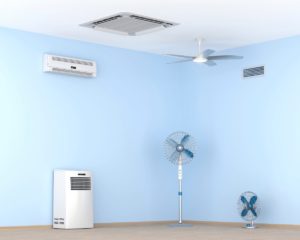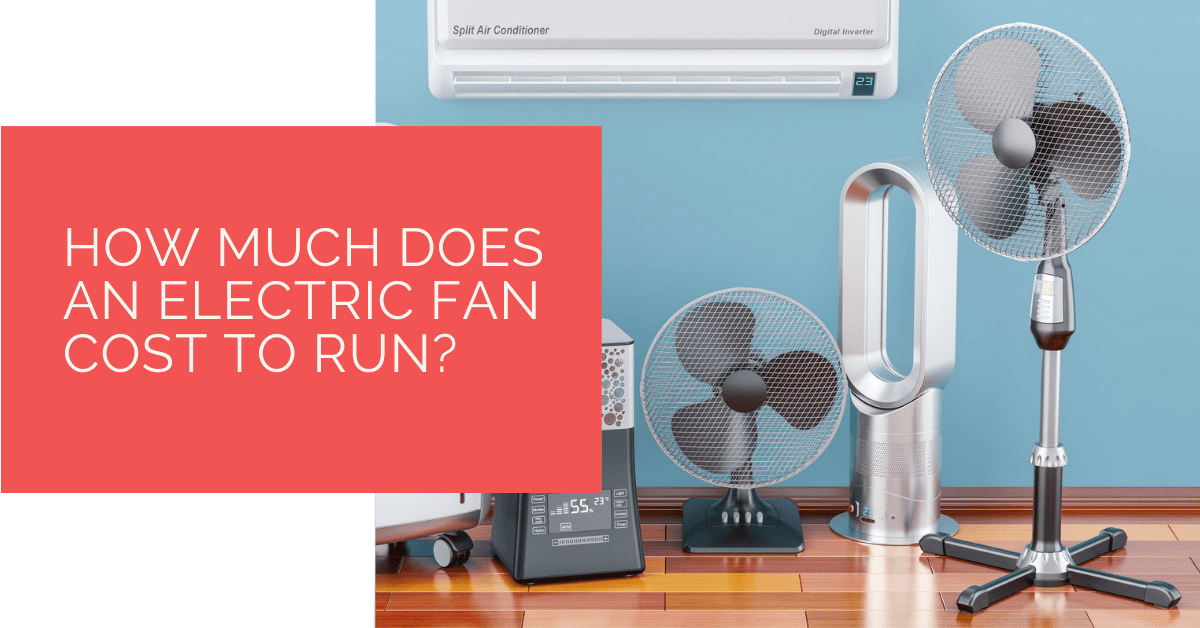Electric fans are a cost-effective solution if you’re looking to beat the summer heat or simply improve air circulation in your home. But have you ever wondered how much running a conventional electric fan costs? In this informative article, we will break down the key factors determining the cost of operating your fan, making it easy to calculate. Plus, we’ll explore different types of electric fans and share some valuable tips on reducing your energy bills while staying comfortably cool.
Electric fans have been a go-to cooling option, especially in regions with hot summers, and understanding their running costs can help you make informed decisions to keep your comfort and budget in check. Whether you’re a fan enthusiast or just seeking a reprieve from the sweltering heat, this article will equip you with the knowledge you need to make efficient and cost-effective choices for staying cool. So, let’s dive in and discover the secrets behind running your electric fan without breaking the bank.
Contents
- 1 Key Takeaways
- 2 How Much Does a Conventional Fan Cost to Run?
- 3 Different Types of Electrics Fans
- 4 How Can You Reduce the Energy Bills of Running a Fan?
- 5 Can You Leave the Ceiling Fan on All Night Long?
- 6 Heat Pump Source: Reliable Heating and Cooling Solutions
- 7 Heat Pump Source: Reliable Heating and Cooling Solutions
- 8 Summing Up
Key Takeaways
- Electric fans are a more sustainable and cost-effective alternative to air conditioners, offering relief from the heat and helping reduce electricity bills.
- You can calculate the cost of running an electric fan by determining its wattage and multiplying it by the price per kilowatt-hour.
- Various types of electric fans, such as desk fans, tower fans, pedestal fans, floor fans, and exhaust fans, offer different cooling levels for various room sizes and needs.
How Much Does a Conventional Fan Cost to Run?
Traditional fans are energy-efficient as compared to an air conditioning unit. You can calculate how much it costs by determining how much electricity it consumes. To do this, you need to check the fan’s wattage, which is usually written in its instruction manual.
Once you know the wattage of your electric fan, you need to convert the figure into kilowatt. This is because the unit of electricity is kilowatt-hour. Moreover, according to the Energy Saving Trust, the average price per kWh of electricity in the United Kingdom is 20.33p.
Now, multiply both the variables, the kilowatt-hours consumed by the electric fan, and the price per kWh together. The resulting output is how much your fan costs to run.
Different Types of Electrics Fans
 Homes in the UK are built to retain heat in cold winter and thus are poorly insulated, which results in overheating. However, according to Chris Michael, managing director of air conditioner manufacturer Meaco, “To reduce the temperature of a room, you’ll need two windows in the room and two fans.”
Homes in the UK are built to retain heat in cold winter and thus are poorly insulated, which results in overheating. However, according to Chris Michael, managing director of air conditioner manufacturer Meaco, “To reduce the temperature of a room, you’ll need two windows in the room and two fans.”
Fans are indispensable on summer nights. Although the air conditioner does offer you respite amidst the sizzling heat but at a handsome price. Additionally, an expensive cooling system is only helpful on the first few hot days.
On the other hand, a humble electric fan is the most common, practical, and effective way to counter the burning heat and sleepless nights. So, below are some affordable fan choices that you can run on long restless nights.
Desk Fans
Desk Fans are compact and suitable for your desk or tables. They provide excellent cooling as they directly circulate air around you. However, they aren’t powerful enough to cool large spaces.
Tower Fans
Tower fans are cost-effective cooling tools. They are tall and sleek, making them suitable for narrow spaces.
Pedestal Fans
Pedestal fans or bladed fans are less energy efficient as compared to tower fans. The larger the blade, the more power they consume. However, their energy consumption is not as high as an air conditioner.
Furthermore, they are very versatile due to their adjustable height and can easily make even a large room cooler.
Floor Fans
Floor fans are similar to pedestal fans; however, their blades are fixed to sit on the floor and not on the top of the stand. These fans are very powerful and capable of cooling large rooms as well.
Exhaust Fans
As much as a good night’s sleep is essential, so is a cold shower. Bathroom extractor fans clear the hot air, moisture, and odors. It also allows for proper air ventilation, making you feel cooler and more comfortable even in your bathroom.
How Can You Reduce the Energy Bills of Running a Fan?
Ceiling fans and traditional fan owe their popularity to their practicality and low electricity costs. Although they might not be the most thrilling purchases, they are amazing to keep stifling heat at bay.
 Then again, if you were to run a fan without paying attention to how much energy it consumes, you might be signing up for a never-ending energy bill.
Then again, if you were to run a fan without paying attention to how much energy it consumes, you might be signing up for a never-ending energy bill.
Running a fan all night long can cause you a dry throat, skin, a stuffy nose, and a possible headache. They also accumulate dust, dirt, mites and blow these towards you, resulting in irritated eyes and nose at times.
Instead, there are other methods you can use to stay cool without needing your fan to run for long hours.
Turn Off The Switch
A typical fan doesn’t cool air; they make you feel more relaxed by properly circulating air around you. Ensure that you switch off your fan when not needed or the temperature lowers significantly. Instead, you can open your bedroom window for better ventilation.
Keep Curtains Closed
Reducing the exposure to sunlight in your room can lower the possibility of overheating your sleeping space. If you cannot keep your entire home from excess sunlight, you can at the very least keep your bedroom blinds shut. This will minimise the sunlight exposure in your bedroom and keep it cool relatively.
Make It Frosty
Rather than keeping your fan on a high setting, you can keep cold water or ice water in front of it for better cooling effects.
Due to the faster rate of evaporation, the droplets of cold or ice water feels like cooling mist when kept in front of the fan.
Clean Your Fan
Fan accumulates dust and dirt quickly, which significantly lowers their efficiency. Hence, you must mindfully clean the fan to ensure that their performance is not compromised.
To clean the fan, you can use a spray bottle filled with a cleaning agent and wipe the blades from time to time.
Can You Leave the Ceiling Fan on All Night Long?
Humid nights make it difficult for a sound sleep at night. However, running your fan on all night might not be a good idea.
The energy costs of running a fan entirely depend on the fan wattage. Therefore, if the wattage of your fan is low, say 30 watts, then it will cost you about £5 per night, which is £35 for a week. Now, if the wattage of your fan is high, say 1000 watts, then it will cost you around £1 per night and £7 for a week.
While it’s very tempting to keep your fan running throughout the night, it might not be the most cost-effective. Not only will your energy bills skyrocket, but you might also feel dehydrated in the morning.
According to Public Health England, fans “can cause excess dehydration” and thus shouldn’t be positioned directly at your body. Now, hot weather and dehydration don’t sound like the best combination, does it?
Heat Pump Source: Reliable Heating and Cooling Solutions
At Heat Pump Source, we take pride in our unwavering commitment to serving the UK with top-tier HVAC solutions. From the efficiency of heat pumps and the cool relief of air conditioning to the warmth of boilers, radiators, and underfloor heating, our dedicated team is always at the forefront of innovation. We understand the unique needs of every household and business, and we strive to provide dependable health and cooling products and services that are tailored just for you. Ensuring your comfort and satisfaction is our utmost priority. Whether you have questions, need guidance, or require support, we’re always here to assist. Please don’t hesitate to contact us; we’re eager to be of service.
Heat Pump Source: Reliable Heating and Cooling Solutions
At Heat Pump Source, we take pride in our unwavering commitment to serving the UK with top-tier HVAC solutions. From the efficiency of heat pumps and the cool relief of air conditioning to the warmth of boilers, radiators, and underfloor heating, our dedicated team is always at the forefront of innovation. We understand the unique needs of every household and business, and we strive to provide dependable health and cooling products and services that are tailored just for you. Ensuring your comfort and satisfaction is our utmost priority. Whether you have questions, need guidance, or require support, we’re always here to assist. Please don’t hesitate to contact us; we’re eager to be of service.
Summing Up
Today, fans come in all shapes and sizes and are a godsend during baking-grilled June. They are convenient and flexible as they can be moved from one place to another.
Though they might not be the most brag-worthy purchase, they do make the high temperature a tad bit more bearable and help you stay cool.
About the Author
At Heat Pump Source, our articles are the product of a collaborative effort among a team of highly skilled HVAC experts. Our dedicated professionals, hailing from diverse backgrounds in heating, ventilation, air conditioning, and refrigeration, contribute their extensive knowledge and experience to every piece of content. This multidisciplinary approach ensures comprehensive coverage. Our commitment is to deliver authoritative, reliable, and tailored advice to meet the unique needs of every household and business across the UK.

